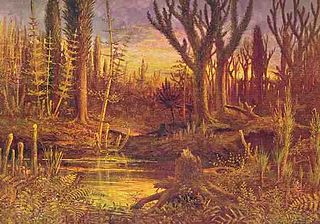Devonium
From Wikipedia, the free encyclopedia
Remove ads
Devonium[1] est systema stratigraphicum et periodus geologica.

Divisio quarta ab infima constituit tam aerae Palaeozoicae quam aeonis Phanerozoicae. Abhinc 4 192 ± 32 centies milium annorum coepit, antecessore Silurio. Finem habuit abhinc 3 589 ± 4 centies milium annorum, successore Carbonifero, secundum scalam aevorum geologicorum Commissionis Internationalis Stratigraphicae.[2] Devonium inceptum ex antiquissimis fossilibus Monograpti uniformis datur.[3]

In tres series dividitur, quae inferius, medium, superius appellantur. In septem stadia dividitur, quae ab infimo ad supremum Lochkovium, Pragium, Emsium, Eifelium, Givetium, Frasnium, Famennium appellantur.[4]
E nomine Devoniae appellatur, regione Angliae occidentalis, ubi strata huius periodi primum recognita sunt. Primum anno 1840 Adam Sedgwick et Rodericus Murchison nomen Anglicum Devonian system definiverunt e propositione Gulielmi Lonsdale. [5][6][7]
Remove ads
Notae
Bibliographia
Nexus externi
Wikiwand - on
Seamless Wikipedia browsing. On steroids.
Remove ads
